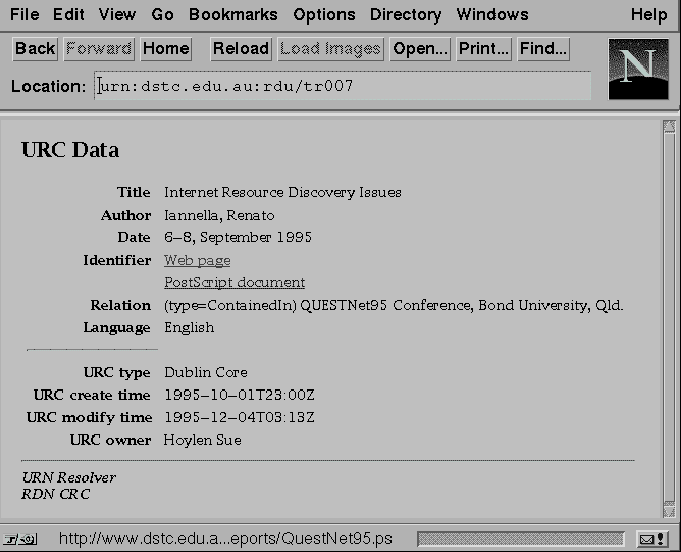
TURNIP
The URN Interoperability Project
Contributed by
Renato Iannella
DSTC Pty Ltd.
D-Lib Magazine, March 1996

Renato Iannella
DSTC Pty Ltd.
D-Lib Magazine, March 1996
For Internet users, the progression to using Uniform Resource Names (URN) will offer tremendous benefits. A excellent coverage of the issues involved was reported in Uniform Resource Names (D-Lib Magazine, February 1996). There has been much discussion on the syntax and how URNs should be deployed on the Internet. This has led to a number of independent groups developing URN services. There was a need to bring together these groups and to learn from their collective experiences.
To foster this work, the URN Interoperability Project (TURNIP) was initiated by the DSTC late last year. This international collaborative effort is providing an experimental testbed for developers of URN services to evaluate their interoperability with other URN resolution services. Participants in the project include:
Each organisation has independently developed URN resolution services, and through the TURNIP process, can now easily resolve each others URNs. Both URN resolvers are based on the use of the HTTP and DNS protocols, and as such, can be readily deployed on the Internet. Since WWW browsers are yet to support URNs, a simple proxy service is used to capture the URNs and forward to the resolver.
As an example, below is a sample list of URNs that can be resolved by the two services:
One of the interesting outcomes of TURNIP is the use of different meta-data schemes. The meta-data, called Uniform Resource Characteristics (URC), are returned from the URN resolver. The DSTC has adopted the Dublin Core meta-data set, and CEO has used the IAFA templates scheme. Both URN resolvers are independent of the URC scheme used, so can freely interoperate. As an example, Figure 1 below shows the output from the resolution of the URN: <urn:inet:dstc.edu.au:rdu/tr007>.
Figure 1 - URC Information

The URC meta-data describes the resource, in this case it describes a conference paper. As can be seen in the Identifier meta-data element, there are two URLs for this conference paper: a HTML and PostScript version. The user can then choose which version of the paper they require and follow that link.
The DSTC is exploiting the URN and URC technology to develop sophisticated resource discovery prototypes in its Open Information Locator (OIL) project. The OIL project addresses the emerging need for the discovery of resources on globally distributed heterogeneous networks. The OIL project takes a global view of resource discovery and focuses on access to large-scale collections of resources. That is, the primary target of OIL are large repositories of resources, such as Digital Libraries and the World Wide Web. A report on the OIL project and Digital Libraries [PostScript] is available.
The next stage of TURNIP is to support the enhanced DNS extensions being proposed and to foster more groups joining the project.
For further information, see the project's home page at http://www.dstc.edu.au/RDU/TURNIP or contact Renato Iannella, at [email protected]
 hdl://cnri.dlib/march96-iannella
hdl://cnri.dlib/march96-iannella